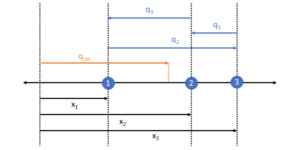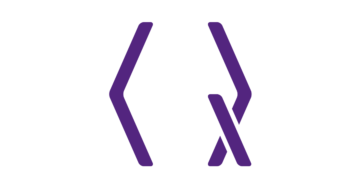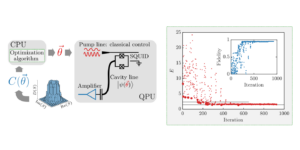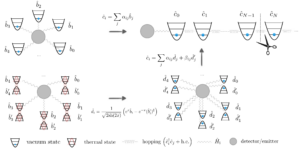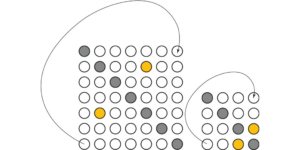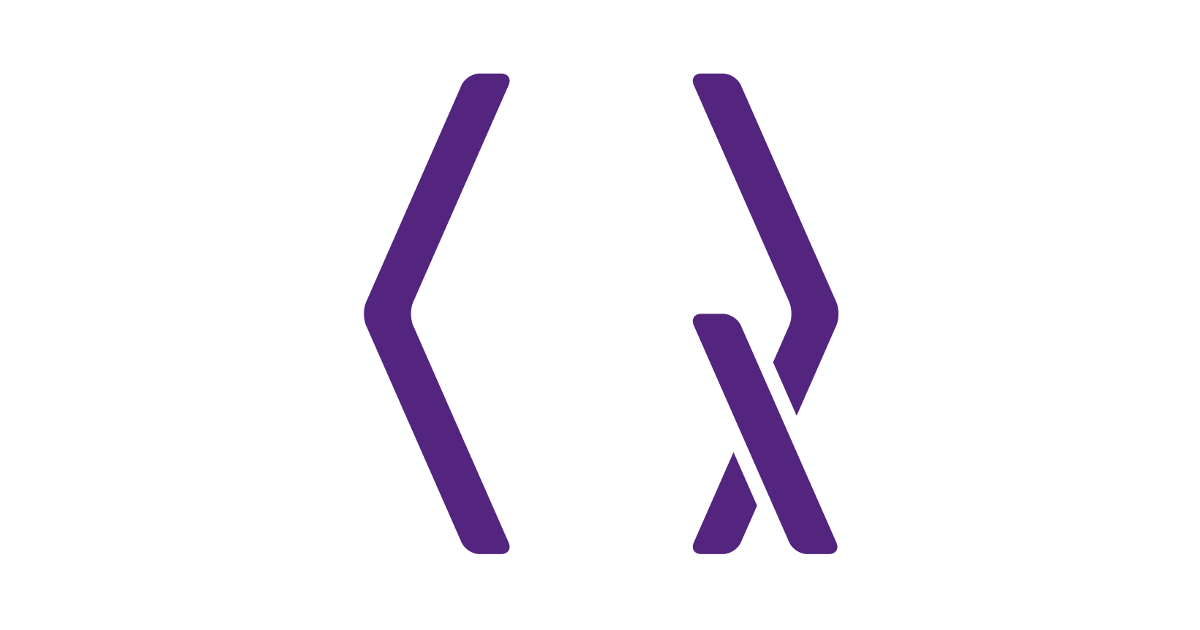
1National Research Council of Canada, 100 Sussex Drive, Ottawa, Ontario K1A 0R6, Canada
2Institute for Quantum Computing and Department of Physics and Astronomy, University of Waterloo, N2L3G1 Waterloo, Ontario, Canada
3Nexus for Quantum Technologies, University of Ottawa, Ottawa, K1N 6N5, ON, Canada
Find this paper interesting or want to discuss? Scite or leave a comment on SciRate.
Abstract
In quantum key distribution (QKD), protocols are tailored to adopt desirable experimental attributes, including high key rates, operation in high noise levels, and practical security considerations. The round-robin differential phase shift protocol (RRDPS), falling in the family of differential phase shift protocols, was introduced to remove restrictions on the security analysis, such as the requirement to monitor signal disturbances, improving its practicality in implementations. While the RRDPS protocol requires the encoding of single photons in high-dimensional quantum states, at most, only one bit of secret key is distributed per sifted photon. However, another family of protocols, namely high-dimensional (HD) QKD, enlarges the encoding alphabet, allowing single photons to carry more than one bit of secret key each. The high-dimensional BB84 protocol exemplifies the potential benefits of such an encoding scheme, such as larger key rates and higher noise tolerance. Here, we devise an approach to extend the RRDPS QKD to an arbitrarily large encoding alphabet and explore the security consequences. We demonstrate our new framework with a proof-of-concept experiment and show that it can adapt to various experimental conditions by optimizing the protocol parameters. Our approach offers insight into bridging the gap between seemingly incompatible quantum communication schemes by leveraging the unique approaches to information encoding of both HD and DPS QKD.
► BibTeX data
► References
[1] C. H. Bennett and G. Brassard, Theoretical Computer Science 560, 7-11 (2014).
https://doi.org/10.1016/j.tcs.2014.05.025
[2] V. Scarani, H. Bechmann-Pasquinucci, N. Cerf, M. Dušek, N. Lütkenhaus, and M. Peev, Reviews of Modern Physics 81, 1301 (2009).
https://doi.org/10.1103/RevModPhys.81.1301
[3] F. Bouchard, R. Fickler, R. Boyd, and E. Karimi, Science Advances 3, e1601915 (2017).
https://doi.org/10.1126/sciadv.1601915
[4] F. Xu, X. Ma, Q. Zhang, H. K. Lo, and J. W. Pan, Reviews of Modern Physics 92, 025002 (2020).
https://doi.org/10.1103/RevModPhys.92.025002
[5] A. K. Ekert, Physical Review Letters 67, 661 (1991).
https://doi.org/10.1103/PhysRevLett.67.661
[6] N. J. Cerf, M. Bourennane, A. Karlsson, and N. Gisin, Physical Review Letters 88, 127902 (2002).
https://doi.org/10.1103/PhysRevLett.88.127902
[7] H. K. Lo, M. Curty, and B. Qi, Physical Review Letters 108, 130503 (2012).
https://doi.org/10.1103/PhysRevLett.108.130503
[8] M. Lucamarini, Z. L. Yuan, J. F. Dynes, and A. J. Shields, Nature 557, 400-403 (2018).
https://doi.org/10.1038/s41586-018-0066-6
[9] T. Sasaki, Y. Yamamoto, and M. Koashi, Nature 509, 475-478 (2014).
https://doi.org/10.1038/nature13303
[10] A. Mizutani, N. Imoto, and K. Tamaki, Physical Review A 92, 060303(R) (2015).
https://doi.org/10.1103/PhysRevA.92.060303
[11] Z. Q. Yin, S. Wang, W. Chen, Y. G. Han, R. Wang, G. C. Guo, and Z. F. Han, Nature Communications 9, 457 (2018).
https://doi.org/10.1038/s41467-017-02211-x
[12] T. Matsuura, T. Sasaki, and M. Koashi, Physical Review A 99, 042303 (2019).
https://doi.org/10.1103/PhysRevA.99.042303
[13] Y.-G. Shan, Z.-Q. Yin, H. Liu, S. Wang, W. Chen, D.-Y. He, G.-C. Guo, and Z.-F. Han, Physical Review A 105, 032441 (2022).
https://doi.org/10.1103/PhysRevA.105.032441
[14] H. Takesue, T. Sasaki, K. Tamaki, and M. Koashi, Nature Photonics 9, 827-831 (2015).
https://doi.org/10.1038/nphoton.2015.173
[15] S. Wang, Z. Q. Yin, W. Chen, D. Y. He, X. T. Song, H. W. Li, L. J. Zhang, Z. Zhou, G. C. Guo, and Z. F. Han, Nature Photonics 9, 832-836 (2015).
https://doi.org/10.1038/nphoton.2015.209
[16] J. Y. Guan, Z. Cao, Y. Liu, G. L. Shen-Tu, J. S. Pelc, M. M. Fejer, C.-Z. Peng, X. Ma, Q. Zhang, and J.-W. Pan, Physical Review Letters 114, 180502 (2015).
https://doi.org/10.1103/PhysRevLett.114.180502
[17] Y. H. Li, Y. Cao, H. Dai, J. Lin, Z. Zhang, W. Chen, Y. Xu, J.-Y. Guan, S.-K. Liao, J. Yin, Q. Zhang, X. Ma, C.-Z. Peng, and J.-W. Pan, Physical Review A 93, 030302(R) (2016).
https://doi.org/10.1103/PhysRevA.93.030302
[18] Q. P. Mao, L. Wang, and S. M. Zhao, Scientific Reports 7, 15435 (2017).
https://doi.org/10.1038/s41598-017-15777-9
[19] K. Wang, I. Vagniluca, J. Zhang, S. Forchhammer, A. Zavatta, J. B. Christensen, and D. Bacco, Physical Review Applied 15, 044017 (2021).
https://doi.org/10.1103/PhysRevApplied.15.044017
[20] F. Bouchard, A. Sit, K. Heshami, R. Fickler, and E. Karimi, Physical Review A 98, 010301(R) (2018).
https://doi.org/10.1103/PhysRevA.98.010301
[21] G. M. Nikolopoulos, K. S. Ranade, and G. Alber, Physical Review A 73, 032325 (2006).
https://doi.org/10.1103/PhysRevA.73.032325
[22] J. Mower, Z. Zhang, P. Desjardins, C. Lee, J. H. Shapiro, and D. Englund, Physical Review A 87, 062322 (2013).
https://doi.org/10.1103/PhysRevA.87.062322
[23] D. Bunandar, Z. Zhang, J. H. Shapiro, and D. R. Englund, Physical Review A 91, 022336 (2015).
https://doi.org/10.1103/PhysRevA.91.022336
[24] Y. Ding, D. Bacco, K. Dalgaard, X. Cai, X. Zhou, K. Rottwitt, and L. K. Oxenløwe, npj Quantum Information 3, 25 (2017).
https://doi.org/10.1038/s41534-017-0026-2
[25] N. T. Islam, C. C. W. Lim, C. Cahall, J. Kim, and D. J. Gauthier, Science Advances 3, e1701491 (2017).
https://doi.org/10.1126/sciadv.1701491
[26] F. Bouchard, K. Heshami, D. England, R. Fickler, R. W. Boyd, B. G. Englert, L. L. Sánchez-Soto, and E. Karimi, Quantum 2, 111 (2018).
https://doi.org/10.22331/q-2018-12-04-111
[27] S. Ecker, F. Bouchard, L. Bulla, F. Brandt, O. Kohout, F. Steinlechner, R. Fickler, M. Malik, Y. Guryanova, R. Ursin, and M. Huber, Physical Review X 9, 041042 (2019).
https://doi.org/10.1103/PhysRevX.9.041042
[28] I. Vagniluca, B. Da Lio, D. Rusca, D. Cozzolino, Y. Ding, H. Zbinden, A. Zavatta, L. K. Oxenløwe, and D Bacco, Physical Review Applied 14, 014051 (2020).
https://doi.org/10.1103/PhysRevApplied.14.014051
[29] B. Da Lio, D. Cozzolino, N. Biagi, Y. Ding, K. Rottwitt, A. Zavatta, D. Bacco, and L. K. Oxenløwe, npj Quantum Information 7, 63 (2021).
https://doi.org/10.1038/s41534-021-00398-y
[30] F. Bouchard, D. England, P. J. Bustard, K. L. Fenwick, E. Karimi, K. Heshami, and B. Sussman, Physical Review Applied 15, 024027 (2021).
https://doi.org/10.1103/PhysRevApplied.15.024027
[31] J. S. Sidhu, T. Brougham, D. McArthur, R. G. Pousa, and D. K. L. Oi, Quantum Technology: Driving Commercialisation of an Enabling Science II 11881, 1188106 (2021).
https://doi.org/10.1117/12.2599044
[32] M. Gündoğan, T. Jennewein, F. K. Asadi, E. Da Ros, et al., arXiv:2111.09595 (2021).
https://doi.org/10.48550/arXiv.2111.09595
arXiv:2111.09595
[33] C. Y. Lu, Y. Cao, C. Z. Peng, and J. W. Pan, Reviews of Modern Physics 94, 035001 (2022).
https://doi.org/10.1103/RevModPhys.94.035001
[34] J. S. Sidhu, T. Brougham, D. McArthur, R. G. Pousa, and D. K. L. Oi, Quantum Computing, Communication, and Simulation III 12446, 129–137 (2023).
https://doi.org/10.1117/12.2651549
[35] T. Islam, J. S. Sidhu, B. L. Higgins, T. Brougham, T. Vergoossen, D. K. L. Oi, T. Jennewein, and A. Ling, arXiv:2204.12509 (2022).
https://doi.org/10.48550/arXiv.2204.12509
arXiv:2204.12509
[36] T. Brougham, S. M. Barnett, K. T. McCusker, P. G. Kwiat, and D. J. Gauthier, Journal of Physics B: Atomic, Molecular and Optical Physics 46, 104010 (2013).
https://doi.org/10.1088/0953-4075/46/10/104010
[37] A Sit, F Bouchard, R Fickler, J Gagnon-Bischoff, H. Larocque, K. Heshami, D. Elser, C. Peuntinger, K. Günthner, B. Heim, C. Marquardt, G. Leuchs, R. W. Boyd, and E. Karimi, Optica 4, 1006–1010 (2017).
https://doi.org/10.1364/OPTICA.4.001006
[38] F. Bouchard, A. Sit, F. Hufnagel, A. Abbas, Y. Zhang, K. Heshami, R. Fickler, C. Marquardt, G. Leuchs, R. W. Boyd, and E. Karimi, Optics Express 26, 22563–22573 (2018).
https://doi.org/10.1364/OE.26.022563
[39] A. Sit, R. Fickler, F. Alsaiari, F. Bouchard, H. Larocque, P. Gregg, L. Yan, R. W. Boyd, S. Ramachandran, and E. Karimi, Optics Letters 43, 4108–4111 (2018).
https://doi.org/10.1364/OL.43.004108
[40] F. Hufnagel, A. Sit, F. Grenapin, F. Bouchard, K. Heshami, D. England, Y. Zhang, B. J. Sussman, R. W. Boyd, G. Leuchs and E. Karimi, Optics Express 27, 26346–26354 (2019).
https://doi.org/10.1364/OE.27.026346
[41] F. Bouchard, F. Hufnagel, D. Koutny, A. Abbas, A. Sit, K. Heshami, R. Fickler, and E. Karimi, Quantum 3, 138 (2019).
https://doi.org/10.22331/q-2019-05-06-138
[42] F. Hufnagel, A. Sit, F. Bouchard, Y. Zhang, D. England, K. Heshami, B. J. Sussman, and E. Karimi, New Journal of Physics 22, 093074 (2020).
https://doi.org/10.1088/1367-2630/abb688
[43] E. Bolduc, N. Bent, E. Santamato, E. Karimi, and R. W. Boyd, Optics Letters 38, 3546–3549 (2013).
https://doi.org/10.1364/OL.38.003546
[44] F. Bouchard, N. H. Valencia, F. Brandt, R. Fickler, M. Huber, and M. Malik, Optics Express 26, 31925-31941 (2018).
https://doi.org/10.1364/OE.26.031925
[45] F. Bouchard, D. England, P. J. Bustard, K. Heshami, and B. Sussman, PRX Quantum 3, 010332 (2022).
https://doi.org/10.1103/PRXQuantum.3.010332
[46] F. Bouchard, K. Bonsma-Fisher, K. Heshami, P. J. Bustard, D. England, and B. Sussman, Physical Review A 107, 022618 (2023).
https://doi.org/10.1103/PhysRevA.107.022618
[47] J. S. Sidhu, S. Izumi, J. S. Neergaard-Nielsen, C. Lupo, and U. L. Andersen, PRX Quantum 2, 010332 (2021).
https://doi.org/10.1103/PRXQuantum.2.010332
[48] S. Izumi, J. S. Neergaard-Nielsen, and U. L. Andersen, PRX Quantum 2, 020305 (2021).
https://doi.org/10.1103/PRXQuantum.2.020305
[49] J. S. Sidhu, M. S. Bullock, S. Guha, and C. Lupo, Quantum 7, 1025 (2023).
https://doi.org/10.22331/q-2023-05-31-1025
Cited by
[1] Frank Schmidt, Daniel Miller, and Peter van Loock, “Error-corrected quantum repeaters with GKP qudits”, arXiv:2303.16034, (2023).
The above citations are from SAO/NASA ADS (last updated successfully 2023-12-14 11:54:09). The list may be incomplete as not all publishers provide suitable and complete citation data.
Could not fetch Crossref cited-by data during last attempt 2023-12-14 11:54:07: Could not fetch cited-by data for 10.22331/q-2023-12-14-1207 from Crossref. This is normal if the DOI was registered recently.
This Paper is published in Quantum under the Creative Commons Attribution 4.0 International (CC BY 4.0) license. Copyright remains with the original copyright holders such as the authors or their institutions.
- SEO Powered Content & PR Distribution. Get Amplified Today.
- PlatoData.Network Vertical Generative Ai. Empower Yourself. Access Here.
- PlatoAiStream. Web3 Intelligence. Knowledge Amplified. Access Here.
- PlatoESG. Carbon, CleanTech, Energy, Environment, Solar, Waste Management. Access Here.
- PlatoHealth. Biotech and Clinical Trials Intelligence. Access Here.
- Source: https://quantum-journal.org/papers/q-2023-12-14-1207/
- :is
- :not
- ][p
- 07
- 09
- 1
- 10
- 100
- 11
- 114
- 12
- 13
- 14
- 15%
- 16
- 17
- 173
- 19
- 20
- 2006
- 2012
- 2013
- 2014
- 2015
- 2016
- 2017
- 2018
- 2019
- 2020
- 2021
- 2022
- 2023
- 22
- 23
- 24
- 25
- 26%
- 27
- 28
- 29
- 30
- 31
- 32
- 33
- 35%
- 36
- 39
- 40
- 41
- 43
- 49
- 54
- 67
- 7
- 8
- 87
- 9
- 91
- 98
- a
- Aaron
- Abbas
- above
- ABSTRACT
- access
- adapt
- adopt
- advances
- affiliations
- AL
- All
- Allowing
- Alphabet
- an
- analysis
- and
- Another
- applied
- approach
- approaches
- ARE
- AS
- astronomy
- At
- atomic
- attempt
- attributes
- author
- authors
- BE
- benefits
- between
- Bit
- both
- Break
- bridging
- by
- CAN
- Canada
- carry
- chen
- Christensen
- comment
- Commons
- Communication
- Communications
- complete
- computer
- computer science
- computing
- conditions
- Consequences
- considerations
- copyright
- could
- Council
- da
- DAI
- Daniel
- data
- dec
- demonstrate
- Department
- Desjardins
- devise
- discuss
- distributed
- distribution
- drive
- driving
- during
- e
- E&T
- each
- enabling
- encoding
- England
- exemplifies
- experiment
- experimental
- explore
- express
- extend
- Falling
- family
- For
- Framework
- frank
- from
- GAO
- gap
- harvard
- he
- here
- High
- higher
- holders
- However
- HTTPS
- i
- if
- ii
- iii
- implementations
- improving
- in
- Including
- incompatible
- information
- insight
- institutions
- interesting
- International
- into
- introduced
- IT
- ITS
- JavaScript
- journal
- Key
- Kim
- large
- larger
- Last
- Leave
- Lee
- levels
- leveraging
- Li
- License
- lin
- List
- May..
- Miller
- Modern
- molecular
- Monitor
- Month
- more
- most
- namely
- Nature
- New
- Noise
- normal
- of
- Offers
- on
- ONE
- only
- Ontario
- open
- operation
- Optical physics
- optics
- optimizing
- or
- original
- our
- pages
- Paper
- parameters
- per
- Peter
- phase
- Photons
- physical
- Physics
- plato
- Plato Data Intelligence
- PlatoData
- potential
- Practical
- protocol
- protocols
- provide
- published
- publisher
- publishers
- Qi
- Quantum
- quantum computing
- quantum information
- quantum technology
- R
- Rates
- recently
- references
- registered
- remains
- remove
- Reports
- requirement
- requires
- research
- restrictions
- review
- Reviews
- s
- scheme
- schemes
- Science
- scientific
- Secret
- security
- seemingly
- shift
- show
- Signal
- simulation
- single
- sit
- song
- States
- Successfully
- such
- suitable
- tailored
- Technologies
- Technology
- than
- that
- The
- their
- theoretical
- this
- Title
- to
- tolerance
- under
- unique
- university
- updated
- URL
- various
- volume
- W
- want
- was
- we
- while
- with
- X
- year
- Yuan
- zephyrnet
- Zhao





